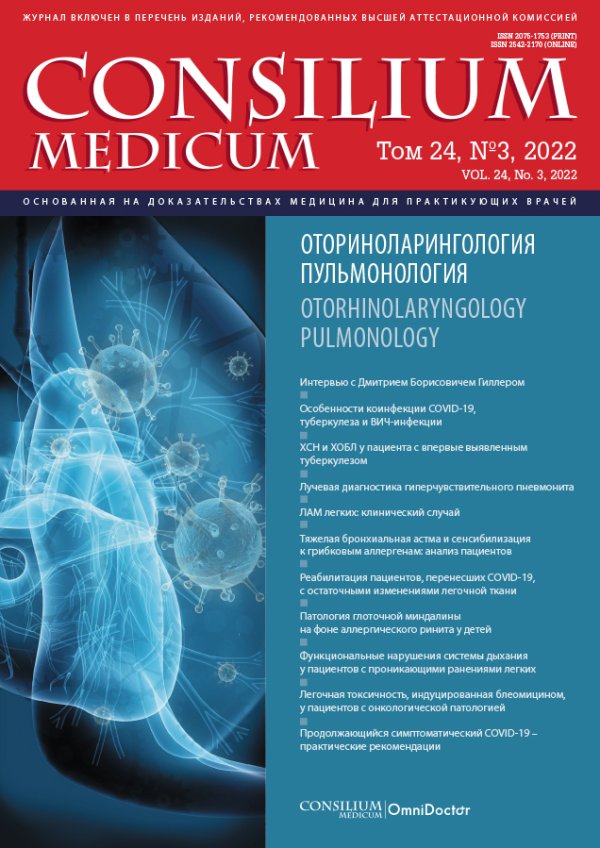Легочная токсичность, индуцированная блеомицином, у пациентов с герминогенными опухолями
- Авторы: Огнерубов Н.А.1, Антипова Т.С.2, Огнерубов С.А.2
-
Учреждения:
- ГБУЗ «Тамбовский областной онкологический клинический диспансер»
- ООО «ПЭТ-Технолоджи», Центр ядерной медицины
- Выпуск: Том 24, № 3 (2022)
- Страницы: 205-208
- Раздел: Статьи
- URL: https://bakhtiniada.ru/2075-1753/article/view/108069
- DOI: https://doi.org/10.26442/20751753.2022.3.201529
- ID: 108069
Цитировать
Полный текст
Аннотация
Введение. Легочная токсичность, индуцированная блеомицином, является опасным осложнением при применении полихимиотерапии у больных с герминогенными опухолями. Она встречается с частотой до 46%, а в 1–4% случаев заканчивается летальным исходом.
Цель. Представить случаи легочной токсичности при проведении полихимиотерапии с включением блеомицина по поводу герминогенных опухолей яичка.
Материалы и методы. Под наблюдением находились 2 пациента в возрасте 43 и 33 лет с герминогенными опухолями яичка, которым после орхифуникулэктомии проводилась полихимиотерапия по схеме ВЕР (блеомицин + этопозид + цисплатин) в стационарном режиме в количестве 4 и 6 циклов соответственно. Позитронно-эмиссионная томография, совмещенная с компьютерной томографией (ПЭТ/КТ), с 18F-фтордезоксиглюкозой выполнялась при появлении клинических симптомов по окончании лечения.
Результаты. Гистологически опухоль у больного 33 лет была представлена смешанной опухолью – семиномой, эмбриональным раком с элементами тератоидного рака. По данным спиральной компьютерной томографии брюшной полости выявлены метастазы в забрюшинные лимфоузлы. У 43-летнего пациента опухоль имела строение эмбрионального рака с множественными метастазами в легкие, лимфоузлы средостения и забрюшинные лимфатические узлы. Проведено 6 циклов и 4 цикла полихимиотерапии по схеме ВЕР соответственно. Кумулятивная доза блеомицина при этом составила 540 и 360 мг за 18 и 12 введений. Лечение сопровождалось развитием фебрильной нейтропении с коррекцией Г-КСФ. Указанные факторы риска следует считать наиболее значимыми. Появление респираторных симптомов в процессе лечения следует расценивать как проявление легочной токсичности. ПЭТ/КТ является методом выбора в постановке диагноза. У наблюдаемых пациентов клиническая картина, равно как и изменения на ПЭТ/КТ, была выявлена через 2 нед по окончании химиотерапии.
Заключение. Легочная токсичность, индуцированная применением блеомицина, у пациентов с герминогенными опухолями яичка является весьма грозным осложнением, порой с летальным исходом. В связи с этим ее ранняя диагностика с учетом факторов риска имеет важное значение в клинической практике. Среди методов медицинской визуализации особую роль играет ПЭТ/КТ, которая позволяет предсказать токсичность до реализации клинического и рентгенологического дебюта.
Ключевые слова
Полный текст
Открыть статью на сайте журналаОб авторах
Николай Алексеевич Огнерубов
ГБУЗ «Тамбовский областной онкологический клинический диспансер»
Автор, ответственный за переписку.
Email: ognerubov_n.a@mail.ru
ORCID iD: 0000-0003-4045-1247
SPIN-код: 3576-3592
д-р мед. наук, канд. юрид. наук, проф., зам. глав. врача по КЭР, засл. работник высшей школы РФ, засл. врач РФ
Россия, ТамбовТатьяна Сергеевна Антипова
ООО «ПЭТ-Технолоджи», Центр ядерной медицины
Email: antipovats@gmail.com
ORCID iD: 0000-0003-4165-8397
врач
Россия, ТамбовСергей Анатольевич Огнерубов
ООО «ПЭТ-Технолоджи», Центр ядерной медицины
Email: ognerubov_n.a@mail.ru
канд. мед. наук, гл. врач
Россия, ТамбовСписок литературы
- Kwan EM, Beck S, Amir E, et al. Impact of Granulocyte-colony Stimulating Factor on Bleomycin-induced Pneumonitis in Chemotherapy-treated Germ Cell Tumors. Clin Genitourin Cancer. 2018;16(1):e193-9. doi: 10.1016/j.clgc.2017.08.012
- Lauritsen J, Kier MGG, Bandak M, et al. Pulmonary Function in Patients With Germ Cell Cancer Treated With Bleomycin, Etoposide, and Cisplatin. J Clin Oncol. 2016;34(13):1492-9. doi: 10.1200/JCO.2015.64.8451
- Vallejo-Torres L, Melnychuk M, Vindrola-Padros C, et al. Discrete-choice experiment to analyse preferences for centralizing specialist cancer surgery services. Br J Surg. 2018;105(5):587-96. doi: 10.1002/bjs.10761
- Raphael MJ, Lougheed MD, Wei X, et al. A Population-Based Study of Pulmonary Monitoring and Toxicity for Patients with Testicular Cancer Treated with Bleomycin. Curr Oncol. 2020;27(6):291-8. doi: 10.3747/co.27.6389
- Necchi A, Miceli R, Oualla K, et al. Effect of Bleomycin Administration on the Development of Pulmonary Toxicity in Patients With Metastatic Germ Cell Tumors Receiving First-Line Chemotherapy: A Meta-Analysis of Randomized Studies. Clin Genitourin Cancer. 2017;15(2):213-20.e5. doi: 10.1016/j.clgc.2016.08.021
- Thakkar D, Ramasamy K, Adithan S, et al. Frequency and risk factors of bleomycin-induced pulmonary toxicity in South Indian patients with germ-cell tumors. J Cancer Res Ther. 2021;17(2):443-9. doi: 10.4103/jcrt.JCRT_348_19
- Zhao Q, Cao D, Yu M, et al. Safety and efficacy of bleomycin/pingyangmycin-containing chemotherapy regimens for malignant germ cell tumor patients in the female genital system. Oncotarget. 2017;8(9):15952-60. doi: 10.18632/oncotarget.15021
- Dejust S, Morland D, Bruna-Muraille C, et al. Everolimus-induced pulmonary toxicity. Medicine (Baltimore). 2018;97(40):e12518. doi: 10.1097/MD.0000000000012518
- Beyhan Sagmen S, Comert S, Turan Erkek E, et al. Can We Predict Bleomycin Toxicity with PET-CT? Acta Haematol. 2019;142(3):171-5. doi: 10.1159/000502374
- Taywade SK, Kumar R, Bhethanabhotla S, Bal C. Role of 18F-FDG PET-CT in Monitoring the Cyclophosphamide Induced Pulmonary Toxicity in Patients with Breast Cancer – 2 Case Reports. Nucl Med Mol Imaging. 2016;50(3):261-5. doi: 10.1007/s13139-015-0388-3
- Falay O, Öztürk E, Bölükbaşı Y, et al. Use of fluorodeoxyglucose positron emission tomography for diagnosis of bleomycin-induced pneumonitis in Hodgkin lymphoma. Leuk Lymphoma. 2017;58(5):1114-22. doi: 10.1080/10428194.2016.1236379
- Simpson A, Paul J, Graham J, Kaye S. Fatal bleomycin pulmonary toxicity in the west of Scotland 1991-95: a review of patients with germ cell tumours. Br J Cancer. 1998;78:1061-6.
- Globocan cancer observatory. 2020. Available at: https://gco.iarc.fr/ Accessed: 25.02.2022.
- Camus P. Interstitial lung disease from drugs, biologics, and radiation. Interstitial Lung Disease. Shelton (CT): People’s Medical Publishing House, 2011.
- Sleijfer S. Bleomycin-induced pneumonitis. Chest. 2001;120(2):617-24.
- Maruyama Y, Sadahira T, Mitsui Y, et al. Prognostic impact of bleomycin pulmonary toxicity on the outcomes of patients with germ cell tumors. Med Oncol. 2018;35(6):80. doi: 10.1007/s12032-018-1140-5
- Nici L, Santos-Moore A, Kuhn C, Calabresi P. Modulation of bleomycin-induced pulmonary toxicity in the hamster by the antioxidant amifostine. Cancer. 1998;83(9):2008-14.
- Dickinson M, Irving L, Hofman M. Early warning signs: FDG-PET to diagnose bleomycin toxicity. Leuk Lymphoma. 2017;58(5):1016-8. doi: 10.1080/10428194.2016.1277387
- O’Sullivan JM, Huddart RA, Norman AR, et al. Predicting the risk of bleomycin lung toxicity in patients with germ-cell tumours. Ann Oncol. 2003;14(1):91-6. doi: 10.1093/annonc/mdg020
- Sun HL, Atenafu EG, Tsang R, et al. Bleomycin pulmonary toxicity does not adversely affect the outcome of patients with Hodgkin lymphoma. Leuk Lymphoma. 2017;58:2607-14. doi: 10.1080/10428194.2017.1307980
Дополнительные файлы








